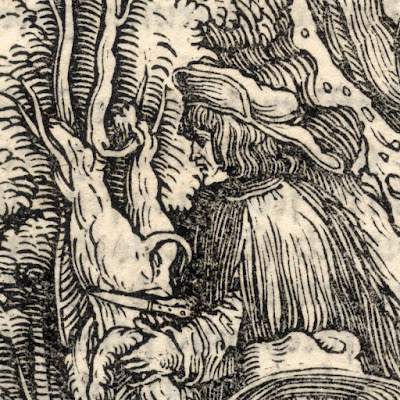Hans Weiditz (II) (aka Master of Petrach) (1495–1537)
“Sheep shearing,
milking and butchery with a pictorial narrative about a king in the distance”
(descriptive title only), 1514–1522 and/or 1532, woodcut illustration to Petrach's
(aka Francesco Petrarca) (1304–1374) “The Artzney Bayder Glück” (aka “Trostspiegel“),
printed by Heinrich Steiner (fl.1522–1548), published in 1532 by Johann
Schott (aka Hans Schotten; Hans Schott; Ioannem Schottum) (fl.early1500s).
Note the
Rijksmuseum offers the following description of the series of prints featuring
this woodcut:
(transl.) “A
king is crowned outside on a field while a crowd attacks a young counselor Illustrations
from "Von der Artzney bayder Glück" by Francesco Petrarca, the
so-called "Trostspiegel" for the first time [series title]”
Woodcut with letterpress text verso on fine laid paper trimmed with a narrow margin
around the image borderline and backed with a support sheet.
Size: (support
sheet) 25.9 x 27.2 cm; (leaf) 14.4 x 15.8; (image borderline) 14.2 x 15.5 cm
Ref: Heinrich
Theodor Musper, “Die Holzschnitte des Petrarkameisters : ein kritisches
Verzeichnis mit einleitung” (The woodcuts of the Petrarch Master: a critical
index with introduction), Munich, 1927; GK Nagler, “Neues allgemeines Künstler-Lexikon”,
xxi, Munich, 1851, p. 364; H Röttinger, “Hans Weiditz der Petrarkameister”,
Strasbourg, 1904; H Röttinger, “Neues zum Werke Hans Weiditz”, in “Mitteilungen
der Gesellschaft für vervielfältigende Kunst”, Vienna, 1911, p. 46ff; W
Scheidig, “Die Holzschnitte des Petrarca-Meisters: Zu Petrarcas Werk, Von der
Artzney bayder Glück”, Berlin, 1955; G Bartrum, “German Renaissance Prints”,
exh. cat., London, BM, 1995, p.160; G Messling, “Beck or the Petrarch Master”,
PQ, June 2004, pp.146–154.
Condition: a museum-quality strong impression (presumably a lifetime
impression as there is minimal wear to the lines) in near perfect condition
apart from a small and virtually invisible restoration to the upper edge of the
sheet. The sheet is backed with an archival support sheet of millennium quality
washi paper.
I am selling
this lifetime impression of an exceptional woodcut by one of the most important
of the Germany printmakers at the beginning of the 1500s for AU$390 in total
(currently US$290.55/EUR248.13/GBP219.20 at the time of posting this listing)
including postage and handling to anywhere in the world (but not, of course,
any import duties/taxes imposed by some countries).
If you are
interested in purchasing this museum-quality woodcut of the utmost rarity—neither
the British Museum nor the Rijksmuseum hold a copy of this print—please contact
me (oz_jim@printsandprinciples.com) and I will send you a PayPal invoice to
make the payment easy.
This print has been sold
Several times I have
been asked if I would list a few prints by Hans Baldung—one of Durer’s pupils.
Sadly, from a brief look I haven’t found any in my collection. Nevertheless,
this print by Hans Wechtlin is probably a good substitute. After all, like
Baldung, Wechtlin is one of the most important German Renaissance woodcut
illustrators and this print certainly reveals why he is so revered for his
curiously engaging compositions.
There is a notable
difference, however, between the works of Baldung and Wechtlin as Giulia
Bartrum (1995) in the British Museum catalogue, “German Renaissance Prints
1490–1550” points out:
“Baldung’s
prints display an overwhelming concern for the interpretation of human emotion
and power rather than for harmonious composition or the technique of
printmaking itself, both of which are important factors in Wechtlin’s work” (p.
64).
Regarding the technical
aspect of this print, I will focus on only one feature that I see as very
revealing in the hope that it “speaks broadly” for Weiditz’s knowledge of his
craft: the way that Weiditz portrays the rock underneath the front foot of
the lamb—a little to the left of centre in the foreground—looking at the
butcher at his work. What is noteworthy about the treatment of this small rock
is that the lines are rendered as black lines whereas the tufts of grass behind
the rock are rendered in white lines. This may seem a rather trivial feature to
focus on, but the juxtaposition of positive (black) lines with negative (white)
lines is a hallmark of a woodcut artist skilled in his craft.








No comments:
Post a Comment
Please let me know your thoughts, advice about inaccuracies (including typos) and additional information that you would like to add to any post.